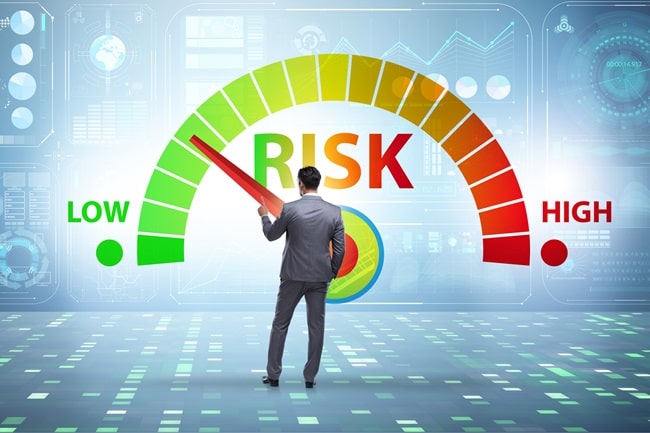
In investing, we frequently discuss the concept of risk tolerance. However, the key question is: how much risk tolerance does each individual need to achieve their investment goals? Let's explore this topic further in the article.
1. What is risk tolerance?
Risk tolerance can be defined as the ability to balance potential profit against the level of risk involved. In other words, higher risks often come with greater potential rewards. It represents the maximum level of risk that an individual is willing to accept for various types of investments.
To clarify the concept of risk tolerance in investing, the U.S. Securities and Exchange Commission (SEC) provides an official definition: 'an investor's ability and willingness to lose part or all of an investment in exchange for greater potential profits.'
From this definition, we can see that assessing an individual's risk tolerance involves two key factors: willingness and ability. Both must be considered together; it’s not enough to focus solely on willingness, which reflects a person's comfort level with risk. The ability to accept risks, based on one’s personal financial situation, also plays a crucial role in shaping overall risk tolerance. In the next section of this article, we will explore the various factors that influence risk tolerance.
2. Four factors affecting risk tolerance
Each individual has a unique level of risk tolerance, influenced by several specific factors:
Goals: Different investment goals result in varying levels of risk tolerance. For instance, investing for long-term growth to accumulate a substantial retirement fund over the next 50 years differs significantly from investing with the immediate goal of purchasing a home. Generally, long-term goals are associated with a higher risk tolerance.
Age: Younger individuals tend to be more risk-averse compared to older individuals, which paradoxically allows them to take on more risk due to their longer investment horizon.
Portfolio Size: A larger portfolio typically corresponds to a higher risk tolerance. An investor with a portfolio of 50 million VND may be willing to take more risks than someone with a portfolio of 5 billion VND, as the larger portfolio can absorb potential losses more comfortably.
Investor Psychology: Each investor reacts differently to risk. Some are more comfortable with taking risks, while others may feel anxious during market fluctuations, even minor corrections. This anxiety can lead many investors to consider selling their portfolios, highlighting that risk tolerance is closely tied to an investor's comfort level with uncertainty.
3. How to assess personal risk tolerance
Risk in investing is an unavoidable factor that we cannot control, and while it presents challenges, it also offers opportunities for experienced investors. To mitigate the impact of risk on personal finances, it's essential to assess our own risk tolerance and develop an appropriate investment strategy. Here are two key factors to consider:
Willingness to accept risk
Individuals vary greatly in their willingness to accept risk, ranging from conservative (risk-averse) to aggressive (open to large risks). This inclination typically remains consistent, even with changes in financial circumstances. For instance, someone who is risk-averse will likely avoid high-risk investments, regardless of whether they have 100,000 VND or 1,000,000 VND to invest. As a result, they may prefer safer options, such as savings deposits.
Financial ability to accept risk
Risk tolerance is also influenced by an individual's financial situation. This is why it's often advised to invest only with "idle" money—funds that you can afford to lose without impacting your personal life or family. As financial obligations increase, an individual’s risk tolerance usually decreases. Conversely, if you are years away from needing your investment capital, you may feel more comfortable taking on risk. The significance of the investment can also affect your risk tolerance; as the stakes rise, caution may increase.
Case studies on risk tolerance
Conservative investors generally prefer to avoid high-risk assets, opting instead for stable investments like savings deposits, bonds, or gold. While these options may not yield substantial short-term profits, they provide a sense of security.
In contrast, younger investors with higher risk tolerance often gravitate toward stocks and emerging markets, seeking significant short-term gains rather than long-term stability. Understanding these preferences allows companies to construct tailored investment portfolios that align with different customer profiles, facilitating growth while respecting individual risk appetites.
The importance of risk tolerance in trading strategies
Recognizing your risk tolerance helps define a comfortable investing zone, optimizing potential profits. Depending on your personal risk tolerance, you may adopt various investment styles to pursue desired returns. For example, those with higher risk tolerance may allocate a larger portion of their portfolio to assets like stocks, bonds, or cryptocurrencies, making it easier to embrace riskier investments in pursuit of higher returns, albeit with the possibility of greater losses.
4. Summary
Risk tolerance refers to the amount of money a person is willing to lose when making their own investment decisions. Several factors influence each individual's risk tolerance. Understanding one’s level of risk tolerance is crucial for effectively planning an investment portfolio, as it guides investment strategies.
For instance, if an individual's risk tolerance is low, their investments will be more conservative, consisting of a greater proportion of low-risk options and fewer high-risk opportunities.
5. FAQs
How are risk tolerance and risk appetite different?
Risk appetite refers to the level of risk an investor is willing to accept in pursuit of their financial goals. In contrast, risk tolerance represents the maximum level of risk an individual is prepared to endure for various types of investments.
What are the types of risk tolerance?
Investors are generally classified into three main categories based on their risk tolerance:
Aggressive: Aggressive investors are typically wealthy and experienced, often managing large portfolios. They prefer assets with significant price fluctuations, which can lead to substantial profits but also considerable losses.
Moderate: Moderate investors accept some risk and usually set a specific percentage of losses they can tolerate. While they earn less than aggressive investors, they also experience smaller losses during market downturns.
Conservative: Conservative investors prioritize capital preservation and take the least amount of risk. Their focus is on avoiding losses rather than seeking high returns.
What happens if we ignore risk tolerance when investing?
Ignoring risk tolerance when investing can lead to poor financial decisions. Without a clear understanding of their risk tolerance, investors may panic during market downturns and sell at a loss. Conversely, a declining market can present excellent buying opportunities. Therefore, assessing your risk tolerance is essential for making informed investment decisions and avoiding hasty, detrimental choices.
Before making any trading decisions, it is important to equip yourself with sufficient fundamental knowledge, have a comprehensive understanding of market trends, be aware of risks and hidden costs, carefully consider investment targets, level of experience, risk appetite, and seek professional advice if necessary.
Furthermore, the content of this article is solely the author's personal opinion and does not necessarily constitute investment advice. The content of this article is for reference purposes only, and readers should not use this article as a basis for any investment decisions.
Investors should not rely on this information as a substitute for independent judgment or make decisions solely based on this information. It does not constitute any trading activity and does not guarantee any profits in trading.
If you have any inquiries regarding the data, information, or content related to Mitrade in this article, please contact us via email: insights@mitrade.com. The Mitrade team will carefully review the content to continue improving the quality of the article.


